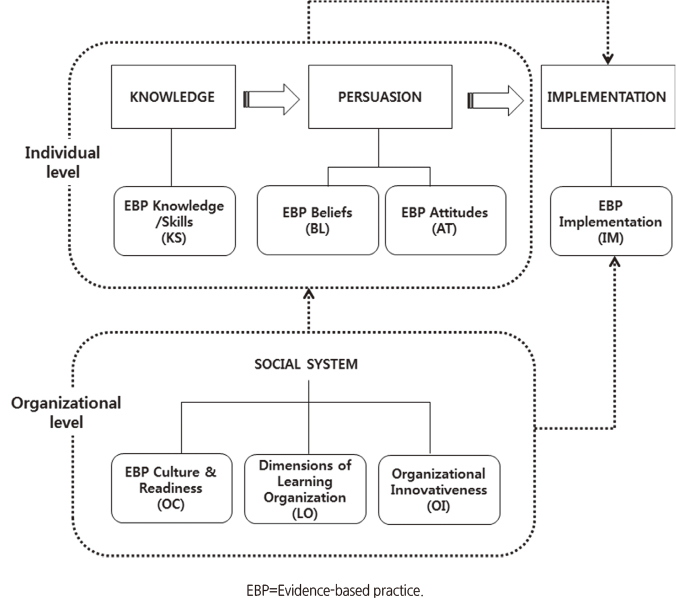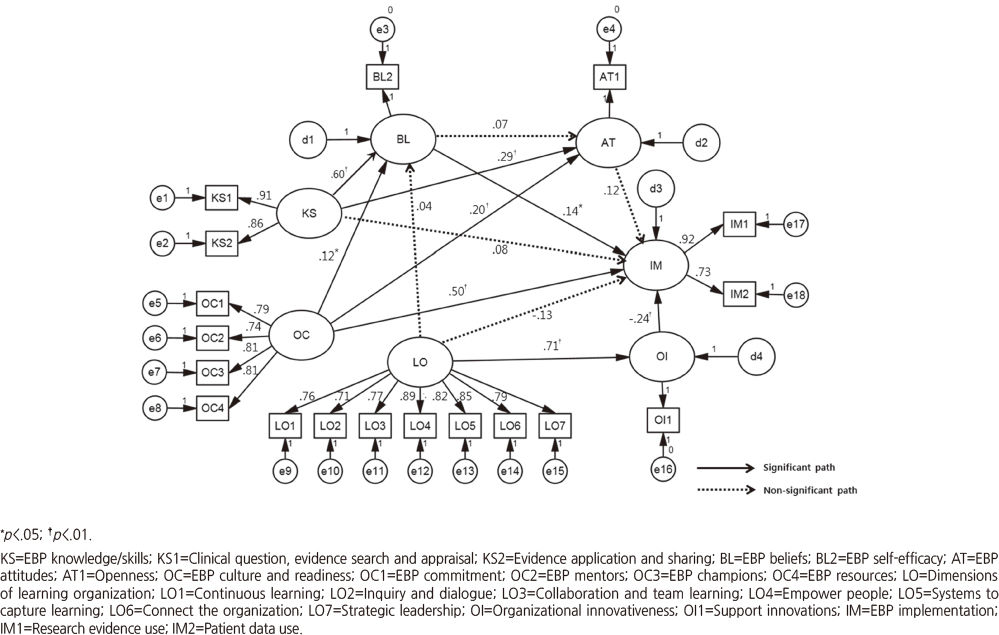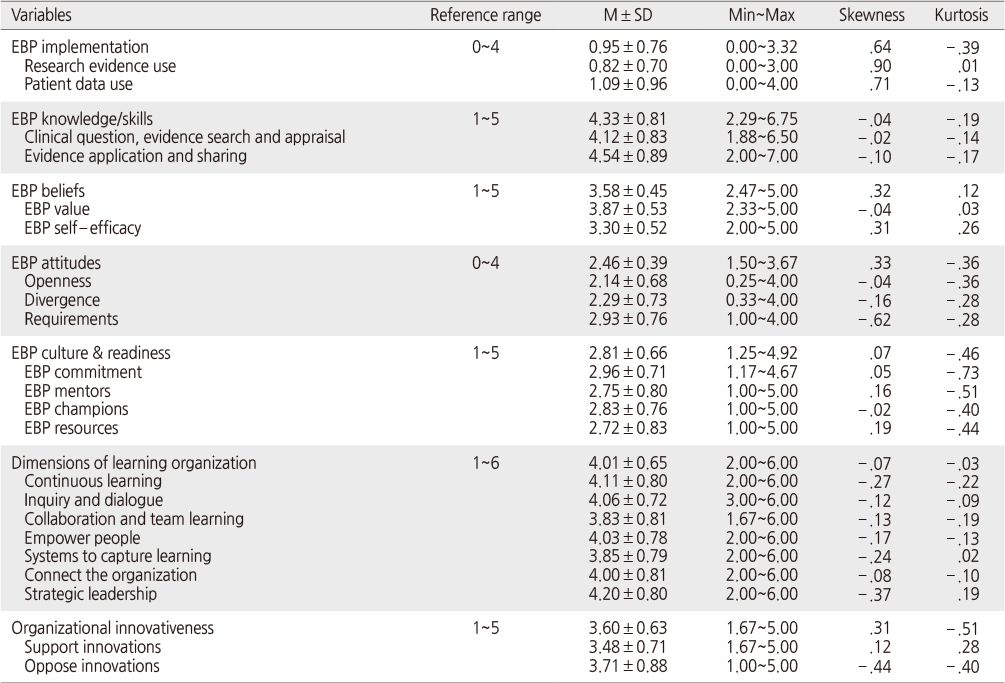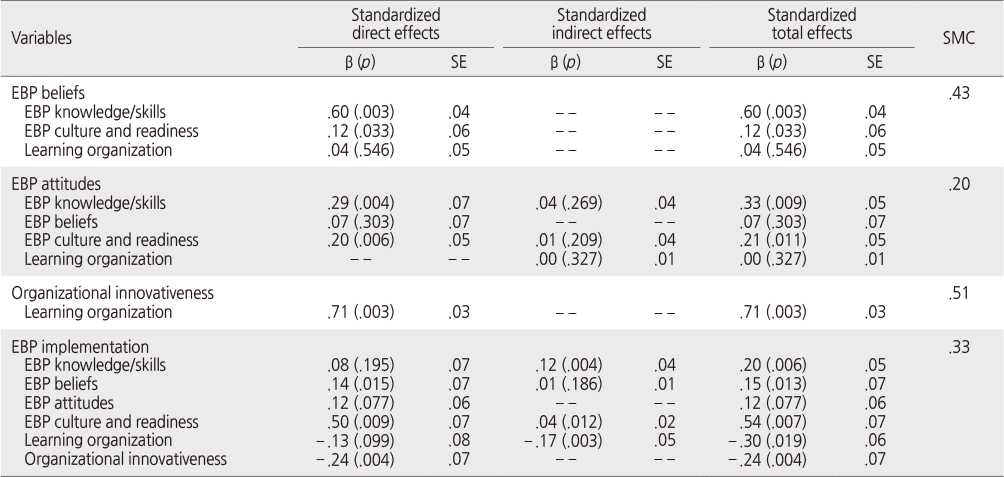Articles
- Page Path
- HOME > J Korean Acad Nurs > Volume 46(5); 2016 > Article
-
Original Article
- Structural Model of Evidence-Based Practice Implementation among Clinical Nurses
- Hyunyoung Park, Keum Seong Jang
-
Journal of Korean Academy of Nursing 2016;46(5):697-709.
DOI: https://doi.org/10.4040/jkan.2016.46.5.697
Published online: October 31, 2016
1Department of Nursing, Honam University, Gwangju, Korea.
2College of Nursing, Chonnam National University·Chonnam Research Institute of Nursing Science, Gwangju, Korea.
- Address reprint requests to: Jang, Keum Seong. College of Nursing, Chonnam National University, 160 Baekseo-ro, Dong-gu, Gwangju 61468, Korea. Tel: +82-62-530-4955, Fax: +82-62-227-4009, jangks@jnu.ac.kr
© 2016 Korean Society of Nursing Science
This is an Open Access article distributed under the terms of the Creative Commons Attribution NoDerivs License. (http://creativecommons.org/licenses/by-nd/4.0/) If the original work is properly cited and retained without any modification or reproduction, it can be used and re-distributed in any format and medium.
Abstract
-
Purpose
- This study was conducted to develop and test a structural model of evidence-based practice (EBP) implementation among clinical nurses. The model was based on Melnyk and Fineout-Overholt's Advancing Research and Clinical Practice through Close Collaboration model and Rogers' Diffusion of Innovations theory.
-
Methods
- Participants were 410 nurses recruited from ten different tertiary hospitals in Korea. A structured self-report questionnaire was used to assess EBP knowledge/skills, EBP beliefs, EBP attitudes, organizational culture & readiness for EBP, dimensions of a learning organization and organizational innovativeness. Collected data were analyzed using SPSS/WINdows 20.0 and AMOS 20.0 program.
-
Results
- The modified research model provided a reasonable fit to the data. Clinical nurses' EBP knowledge/skills, EBP beliefs, and the organizational culture & readiness for EBP had statistically significant positive effects on the implementation of EBP. The impact of EBP attitudes was not significant. The dimensions of the learning organization and organizational innovativeness showed statistically significant negative effects on EBP implementation. These variables explained 32.8% of the variance of EBP implementation among clinical nurses.
-
Conclusion
- The findings suggest that not only individual nurses' knowledge/skills of and beliefs about EBP but organizational EBP culture should be strengthened to promote clinical nurses' EBP implementation.
This manuscript is a condensed form of the first author's doctoral dissertation from Chonnam National University.
The authors declared no conflict of interest.
- 1. Melnyk BM, Fineout-Overholt E. Evidence-based practice in nursing & healthcare: A guide to best practice. 2nd ed. Philadelphia, PA: Lippincott Williams & Wilkins; 2011. p. 1–599.
- 2. Yi J, Park M. Nurses’ access & use of information resources and barriers & competency of evidence based practice. Korean J Adult Nurs. 2011;23(3):255–266.
- 3. Rogers EM. Kim YS Kang NW Park HK . Diffusion of innovations. 5th ed. New York, NY: The Free Press; 2003. p. 1–576.
- 4. Meijers JM, Janssen MA, Cummings GG, Wallin L, Estabrooks CA, Halfens RY. Assessing the relationships between contextual factors and research utilization in nursing: Systematic literature review. J Adv Nurs. 2006;55(5):622–635. ArticlePubMed
- 5. Melnyk BM, Fineout-Overholt E, Fischbeck Feinstein N, Li H, Small L, Wilcox L, et al. Nurses’ perceived knowledge, beliefs, skills, and needs regarding evidence-based practice: Implications for accelerating the paradigm shift. Worldviews Evid Based Nurs. 2004;1(3):185–193. ArticlePubMedPDF
- 6. Estrada N. Exploring perceptions of a learning organization by RNs and relationship to EBP beliefs and implementation in the acute care setting. Worldviews Evid Based Nurs. 2009;6(4):200–209. ArticlePubMed
- 7. Aarons GA, Sommerfeld DH, Walrath-Greene CM. Evidence-based practice implementation: The impact of public versus private sector organization type on organizational support, provider attitudes, and adoption of evidence-based practice. Implement Sci. 2009;4:83ArticlePubMedPMCPDF
- 8. Sta. Maria RF, Watkins K. Perception of learning culture and concerns about the innovation on its use: A question of level of analysis. Hum Res Dev Inst. 2003;6(4):491–508. Article
- 9. Scott SG, Bruce RA. Determinants of innovative behavior: A path model of individual innovation in the workplace. Acad Manage J. 1994;37(3):580–607. Article
- 10. Melnyk BM, Fineout-Overholt E. Putting research into practice, Rochester ARCC. Reflections on Nursing Leadership. 2002;28(2):22–25.
- 11. Melnyk BM, Fineout-Overholt E, Giggleman M, Cruz R. Correlates among cognitive beliefs, EBP implementation, organizational culture, cohesion and job satisfaction in evidence-based practice mentors from a community hospital system. Nurs Outlook. 2010;58(6):301–308. ArticlePubMed
- 12. Wallen GR, Mitchell SA, Melnyk B, Fineout-Overholt E, Miller-Davis C, Yates J, et al. Implementing evidence-based practice: Effectiveness of a structured multifaceted mentorship programme. J Adv Nurs. 2010;66(12):2761–2771. ArticlePubMedPMC
- 13. Thiel L, Ghosh Y. Determining registered nurses’ readiness for evidence-based practice. Worldviews Evid Based Nurs. 2008;5(4):182–192. ArticlePubMed
- 14. Côté F, Gagnon J, Houme PK, Abdeljelil AB, Gagnon MP. Using the theory of planned behaviour to predict nurses’ intention to integrate research evidence into clinical decision-making. J Adv Nurs. 2012;68(10):2289–2298. ArticlePubMed
- 15. Koo JM, Song HD. A study on the relationship between creative climate, dimensions of learning organization, and organizational innovativeness: Based on employees of advertising agencies. J Creativity Innov. 2014;7(2):75–109.
- 16. Ferguson LM, Day RA. Challenges for new nurses in evidence-based practice. J Nurs Manag. 2007;15(1):107–113. ArticlePubMed
- 17. Bentler PM, Chou CP. Practical issues in structural modeling. Sociol Methods Res. 1987;16(1):78–117. ArticlePDF
- 18. Bae BR. Structural equation modeling with Amos 19: Principles and practice. Seoul: Chungram Books; 2011. p. 1–668.
- 19. Melnyk BM, Fineout-Overholt E, Mays MZ. The evidence-based practice beliefs and implementation scales: Psychometric properties of two new instruments. Worldviews Evid Based Nurs. 2008;5(4):208–216. ArticlePubMed
- 20. Upton D, Upton P. Development of an evidence-based practice questionnaire for nurses. J Adv Nurs. 2006;53(4):454–458. ArticlePubMed
- 21. Lim KC, Park KO, Kwon JS, Jeong JS, Choe MA, Kim JH, et al. Registered nurses’ knowledge, attitudes, and practice about evidence-based practice at general hospitals in Korea. J Korean Clin Nurs Res. 2011;17(3):375–387.
- 22. Aarons GA. Mental health provider attitudes toward adoption of evidence-based practice: The evidence-based practice attitude scale (EBPAS). Ment Health Serv Res. 2004;6(2):61–74. ArticlePubMedPMC
- 23. Jung EH. A study on the community mental health service provider’s attitude toward adoption of evidence-based practice: Focusing on the effect of leadership. Stud J Soc Welf. 2008;1:205–227.
- 24. Fineout-Overholt E, Melnyk BM. Organizational culture and readiness for system-wide implementation of EBP (OCR-SIEP) scale. Gilbert, AZ: ARCC llc Publishing; 2006.
- 25. Watkins KE, Marsick VJ. Sculpting the learning organization: Lessons in the art and science of systemic change. San Francisco, CA: Jossey-Bass; 1993. p. 1–298.
- 26. Yang B, Watkins KE, Marsick VJ. The construct of the learning organization: Dimensions, measurement, and validation. Hum Resour Dev Q. 2004;15(1):31–55. Article
- 27. Hurley RF, Hult TM. Innovation, market orientation, and organizational learning: An integration and empirical examination. J Mark. 1998;62(3):42–54. ArticlePDF
- 28. Jeon YG. The relationship of transformational leadership to cooperative behavior, creativity, and organizational innovativeness: The moderation of learning orientation: Focused on resort firms in Kang Won province [dissertation]. Gangneung, Kwandong University. 2008;1–146.
- 29. Hu LT, Bentler PM. Cutoff criteria for fit indexes in covariance structure analysis: Conventional criteria versus new alternatives. Struct Equ Modeling. 1999;6(1):1–55. Article
- 30. Hong S. The criteria for selecting appropriate fit indices in structural equation modeling and their rationales. Korean J Clin Psychol. 2000;19(1):161–177.
- 31. Chang AM, Crowe L. Validation of scales measuring self-efficacy and outcome expectancy in evidence-based practice. Worldviews Evid Based Nurs. 2011;8(2):106–115. ArticlePubMed
- 32. Melnyk BM. Strategies for overcoming barriers in implementing evidence-based practice. Pediatr Nurs. 2002;28(2):159–161.PubMed
- 33. Montaño D, Kasprzyk D. Theory of reasoned action, theory of planned behavior, and the integrated behavioral model. In: Glanz K, Rimer BK, Viswanath K, editors. Health behavior: Theory, research, and practice. 5th ed. San Francisco, CA: Jossey-Bass; 2015. p. 95–124.
- 34. Kwon JS. Employee’s defensive behavior against organizational innovation. J Bus Res. 2000;15(2):177–206.
- 35. Sandström B, Borglin G, Nilsson R, Willman A. Promoting the implementation of evidence-based practice: A literature review focusing on the role of nursing leadership. Worldviews Evid Based Nurs. 2011;8(4):212–223. ArticlePubMed
- 36. Profetto-McGrath J. Critical thinking and evidence-based practice. J Prof Nurs. 2005;21(6):364–371. ArticlePubMed
- 37. Ross J. Information literacy for evidence-based practice in perianesthesia nurses: Readiness for evidence-based practice. J Perianesth Nurs. 2010;25(2):64–70. ArticlePubMed
REFERENCES
Figure & Data
REFERENCES
Citations

- Factors influencing on future core nursing competency: focusing on King’s Dynamic Interaction System Model in South Korea: a cross-sectional study
Cheol Eon Park, Jeonghun Kang, Soon Hyun Myung, Hyun Seo Yoo, In Young Cho
Child Health Nursing Research.2025; 31(2): 120. CrossRef - Factors Influencing Evidence-Based Practice Implementation Among Nurses in Psychiatric–Mental Health Hospitals
Moonhee Gang, Yujin Ahn, Donghyeon Gwak
Journal of Psychosocial Nursing and Mental Health Services.2025; : 1. CrossRef - Developing and evaluating an evidence-based practice research competency enhancement program for clinical nurses in Korea: a pilot study
Suhyun Kim, Hye Won Jeong
BMC Nursing.2024;[Epub] CrossRef - Evidence-Based Practice Among Psychiatric Nurses: Knowledge, Attitudes, Organizational Readiness, Levels of Implementation, and Barriers and Facilitators
Chinwe Florence Samantha Ezeruigbo
Journal of Psychosocial Nursing and Mental Health Services.2023; 61(9): 47. CrossRef - Development and Evaluation of Evidence-Based Nursing Protocol for Extracorporeal Membrane Oxygenation to Critically Ill Patients
Soomi Kim, Chul-Gyu Kim
Journal of Korean Academy of Nursing.2023; 53(3): 275. CrossRef - Evaluating the performance of an integrated evidence-based nursing knowledge management (I-EBNKM) platform in real-world clinical environments
Myonghwa Park, Insook Jang, Sung Lim Kim, Wonjae Lim, Ga Ae Kim, Gyeongho Bae, Yerin Kim
International Journal of Medical Informatics.2023; 179: 105239. CrossRef - Sociodemographic and Work-Related Variables Affecting Knowledge of, Attitudes toward, and Skills in EBNP of Nurses According to an EBPPQ
Katarzyna Młynarska, Elżbieta Grochans, Magdalena Sylwia Kamińska, Anna Maria Cybulska, Mariusz Panczyk, Ewa Kupcewicz
International Journal of Environmental Research and Public Health.2022; 19(14): 8548. CrossRef - Development and Effectiveness of Practice Application Program of Intravenous Infusion Evidence-Based Nursing Practice Guideline - for Small and Medium Sized Hospitals
Inhwa Hong, Young Eun
Journal of Korean Academy of Nursing.2020; 50(6): 863. CrossRef - Clinical nurses’ beliefs, knowledge, organizational readiness and level of implementation of evidence-based practice: The first step to creating an evidence-based practice culture
Jae Yong Yoo, Jin Hee Kim, Jin Sun Kim, Hyun Lye Kim, Jung Suk Ki, Tim Schultz
PLOS ONE.2019; 14(12): e0226742. CrossRef - Effects of an Evidence-Based Practice (EBP) Education Program on EBP Practice Readiness and EBP Decision Making in Clinical Nurses
Ae Ri Na Nam, Eun Ho Lee, Jeong Ok Park, Eun Jung Ki, Su Min Nam, Mi Mi Park
Journal of Korean Academy of Nursing Administration.2017; 23(3): 239. CrossRef - Factors Influencing Nurses' Implementation of Evidence-based Fall Management in Geriatric Hospitals
Hyun Jeong, Myonghwa Park
Journal of Korean Academy of Nursing Administration.2017; 23(3): 270. CrossRef - Factors Influencing Nurses’ Implementation of Evidence-based Restraint Use in Long-term Care Hospitals
Myonghwa Park, Mi Hwa Park
Journal of Korean Gerontological Nursing.2016; 18(3): 172. CrossRef


Figure 1
Figure 2
Descriptive Statistics of Observed Variables (N=410)
EBP=Evidence-based practice.
Goodness of Model Fit Indices (N=410)
TLI=Tuker-Lewis index; CFI=Comparative fit index; RMSEA=Root mean square error of approximation; SRMR=Standardized root mean square residual.
Effects of Predictive Variables in the Modified Model (N=410)
EBP=Evidence-based practice; β=Standardized regression weights; SE=Standard errors; SMC=Squared multiple correlations.
EBP=Evidence-based practice.
TLI=Tuker-Lewis index; CFI=Comparative fit index; RMSEA=Root mean square error of approximation; SRMR=Standardized root mean square residual.
EBP=Evidence-based practice; β=Standardized regression weights; SE=Standard errors; SMC=Squared multiple correlations.
 KSNS
KSNS
 E-SUBMISSION
E-SUBMISSION





 Cite
Cite

